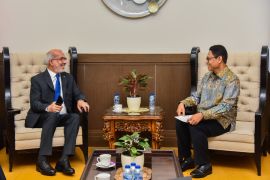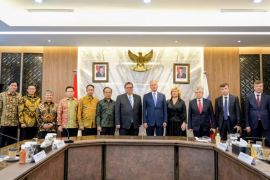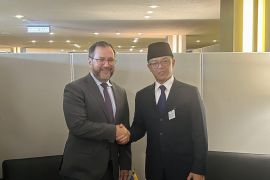At that time (when the pandemic struck), the economy became difficultJakarta (ANTARA) - Lying close to the Island of Belakangpadang, across from Batam Island and the Singapore Strait, Amat Belanda Island enjoys a strategic location in the middle of a developing shipyard industrial area.
Due to its strategic location, the island was once a busy area visited by many tourists, mostly from Singapore.
"Back then (this island) was a very busy area," said Ani, who migrated to the island in 1993.
As many Singaporean tourists visited the island, the locals had more Singapore dollars than rupiahs, she said.
Its people's economy also improved, with some residents peddling food, others ferrying residents or travelers on outboard engine ships, like Ani's husband.
Unfortunately, the growing economic activity on the island did not last. From the 2000s, the number of tourists coming to the island declined from year to year.
The situation worsened after most countries in the world, including Indonesia, were hit by the COVID-19 pandemic in early 2020. Even now, borders between countries have remained closed. Thus, the island has seen no visitors.
Related news: On the scent of the Dutch nutmeg on Banda Islands
"At that time (when the pandemic struck), the economy became difficult," said Ani, flipping through rengkam, a type of seaweed, which her husband had just scooped out from the surrounding waters.
Rengkam, a brown algae plant with the Latin name Sargassum sp, has lately become sought after by fishermen due to its fairly high sale value once dried.
Rengkam paradise
A resident of the Pulau Amat Belanda, Ncen (63), stood on an outboard engine ship. Her husband sat at the end, steering the boat.
With a fairly quick movement, Ncen dipped a long log into the sea and lifted it back up. Wet, sticky, and fishy rengkam came out, stuck to the log, and Ncen added it to the growing heap of rengkam on her boat.
"I just went to sea, as before that I was looking for gelatin (seaweed). So I'm late," said the woman, who recently became a grandmother.
Usually, Ncen goes to sea with her husband around 5.30 a.m. local time. But, on Friday (July 19, 2021), she set out on their boat around 9.30 a.m. local time.
Ncen and her family have turned to rengkam to earn a living since October, 2020. Ncen and her husband hunt for the seaweed in the sea, while their son processes and grinds dried rengkam.
Related news: Good Morning Rinjani!
In the past, their boat was used by their children for offering transportation between islands. However, due to the COVID-19 pandemic, many residents are staying at home, so their services are no longer needed.
"So that's why I use the ship," said the nomad from West Java.
Hadidi (50) is doing the same thing. He said he has been forced to use his ship to find rengkam. Before the pandemic, he ferried residents and goods to several islands on his boat.
"Since the pandemic, (tourism activities have become) very quiet. So, we have to look for other businesses," said Hadidi, who is joined by his wife as he ventures into the sea. Taking their spouses to the sea has become a common practice among fishermen from the island lately.
That afternoon, Hadidi looked happy to see the pile of rengkam heaped up in the middle of the ship, while his wife was busy removing water from the boat using a small dipper.
The income from collecting rengkam is not too much, he said. It is still more profitable to rent a boat and transport passengers between islands, he added.
However, the COVID-19 pandemic has closed many options for locals, who have turned to rengkam to earn an income amid the current uncertain economic conditions.
"I can collect 100 kg (of rengkam) a day. But this doesn't happen every day. It depends on the weather," he said.
When the sea waters begin to rise at around 10-11 a.m. local time, the rengkam seekers return to their homes. They then dry rengkam on poles, and also along the road.
After two days of drying, the rengkam is usually completely dry and ready to be processed. It is then sold to collectors. Each kilogram of dry rengkam is valued at Rp1,300.
Rengkam exports
After the rengkam is dry, the fishermen, who are members of the Pospera Fishermen's Group, sell the seaweed to a factory, which is also located on Pulau Amat Belanda.
There, a woman with a sweet smile, Aprianti Kapur, is ready to serve the residents. She weighs the rengkam that has been packed in white sacks.
If the rengkam is not completely dry or crushed, she uses a machine to process it.
"I'm the only one who can operate this machine as it has to be fast. Our soul must be in tune with the machine," said Kapur.
After it is collected, the rengkam is taken to collectors at the Barelang II Bridge to be exported to Vietnam as high-value animal feed.
Almost all residents of Pulau Amat Belanda are currently involved in rengkam collection.
This new source of livelihood has been able to revive the economy on the island, which has slumped since the 2000s, when visitors to the island dwindled.
Related news: Superior Indonesian soybeans
The sub-district head of Belakangpadang, Yudi Admaji, said collecting rengkam has helped improve the economy on the island.
However, the search area for the seaweed needs to be limited so as not to disturb the aquatic ecosystem in the area, he added.
"Initially, (searching for rengkam) could only be done around the Pulau Amat Belanda, but now fishermen are allowed to go a little further. It's okay, as long as it doesn't reach the waters of other islands, where there are many kelongs and traps (a type of tool for catching fish) belonging to residents," Admaji said.
Rengkam is a favorite of fish, so it should not be overexploited, he added.
In the waters around Pulau Amat Belanda, the number of fish is relatively small, he pointed out. Rengkam is so abundantly available in the area that it would go to waste if not used, he added.
Related news: Tracking the spice trail to Banda
On the other hand, there are many fish in the waters of the surrounding islands, and rengkam is needed by the fish to live, he noted.
Fishermen depend on the waters for their livelihood. Hence, the local government must be wise in dividing the use of waters to choose where rengkam can be collected and where it needs to be conserved for fish, he said.
This will ensure the utilization of the territorial waters does not cause conflict between fishermen, he said. On the other hand, the waters could become a center for rengkam cultivation that can improve the welfare of the community, he added.
Related news: NTT reopens Padar Island to tourists
Related news: Embassy holds virtual tour during '10 New Bali' book launch
Editor: Fardah Assegaf
Copyright © ANTARA 2021












